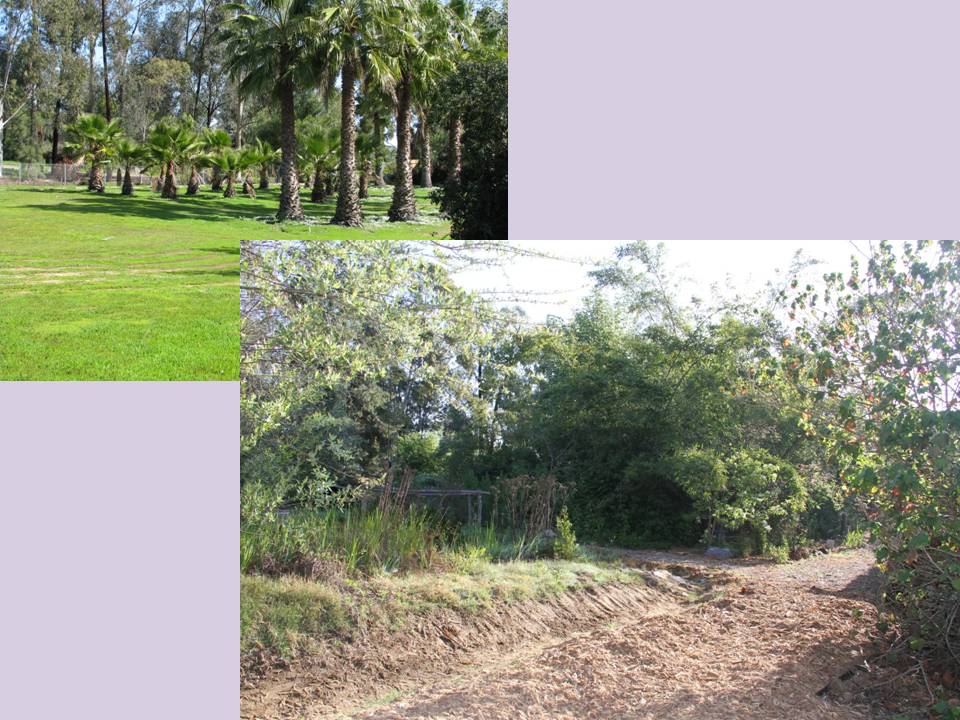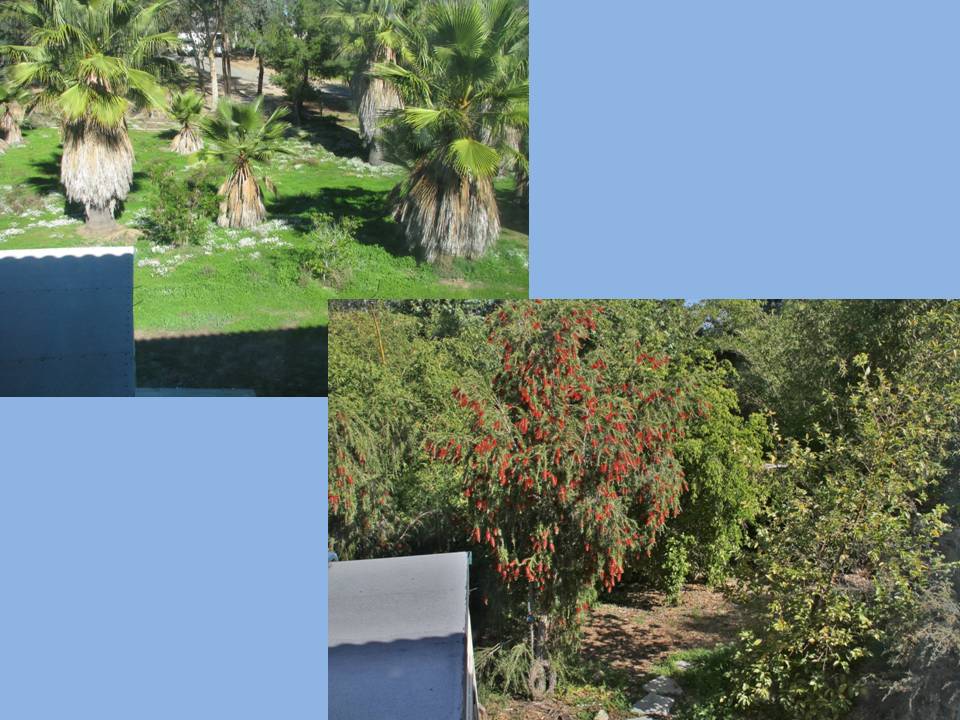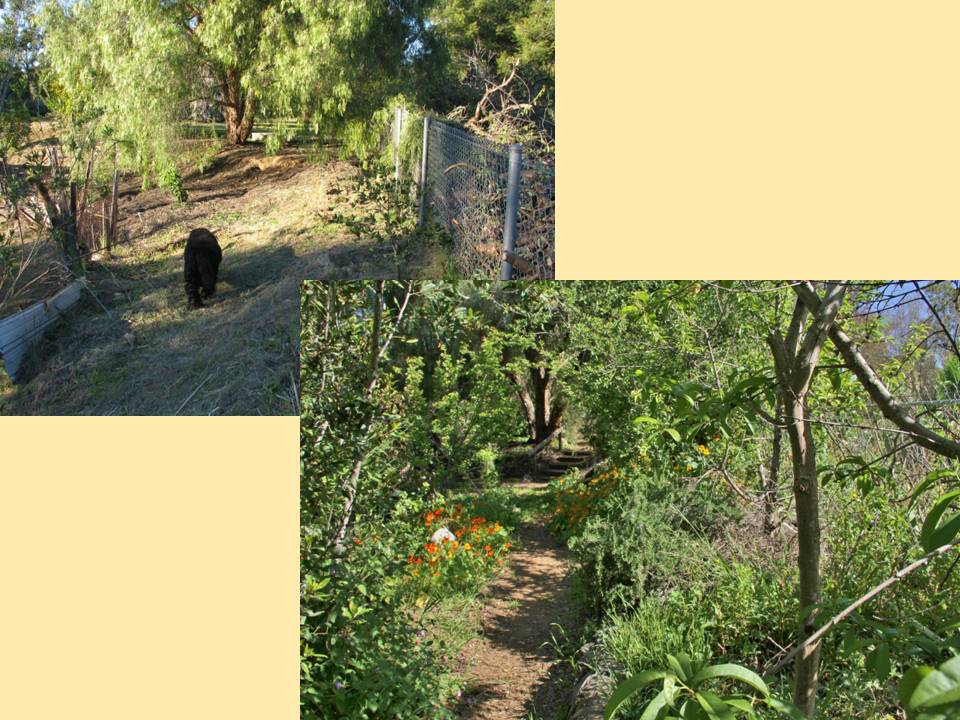- Bees, Compost, Gardening adventures, Heirloom Plants, Hugelkultur, Irrigation and Watering, Other Insects, Perennial vegetables, Permaculture and Edible Forest Gardening Adventures, Planting, Seeds, Soil, Vegetables, Vegetarian, Water
Tomatoes
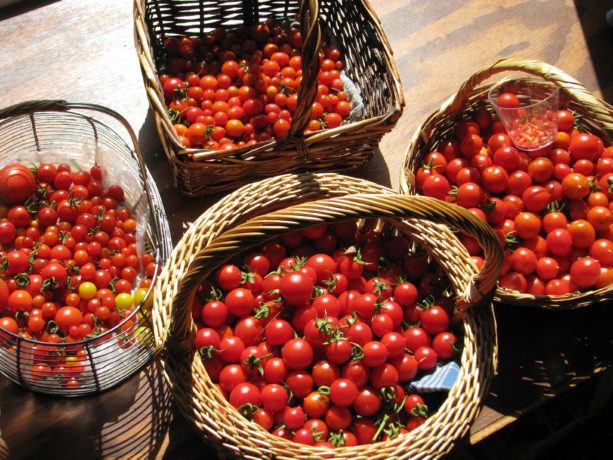 Guess what we picked today? I’ve just finished freezing the large ones to make into tomato jam and tomato sauce later, or seasoning and setting the smaller ones out to sun dry.
Guess what we picked today? I’ve just finished freezing the large ones to make into tomato jam and tomato sauce later, or seasoning and setting the smaller ones out to sun dry.  We’ll sell these fantastically tasty foods at our Marketplace in November.
We’ll sell these fantastically tasty foods at our Marketplace in November.Last year, 2016, we had no tomatoes until the Fall. I couldn’t figure out why. Our summer temperatures were over 100F for days on end, peaking at 116F several of those days. The nights never cooled off and sleeping was difficult. It turns out that the tomatoes didn’t like the heat either. If temperatures consistently stay over 85F and don’t dip below 75F at night then the flowers won’t set fruit. And here I was thinking that tomatoes loved the heat! They just love the warmth, like I do.

Tomato flowers are self-pollinating. Each has both male and female parts and it takes vibration from winged insects and gentle warm winds to pollinate. Others flick them with their fingers, or set a tuning fork on them to simulate insect vibration. If there are very hot, dry winds, pollen dries out and isn’t viable. If the humidity is so high that it is sticky out the pollen swells and sticks, unable to fall to the female part of the flower. When the temperatures lowered in the Fall, even though the day length was shorter, the tomatoes quickly put on fruit.

Here in Southern California’s inland area we don’t receive snow, so tomatoes can last outside as a perennial vine for several years. However a good way to keep tomatoes for use after summer is to prune it, hanging the vine with the tomatoes in a dry area with good air circulation. The vine will die but the tomatoes – especially sauce or paste tomatoes such as Roma – will stay in excellent condition for months.
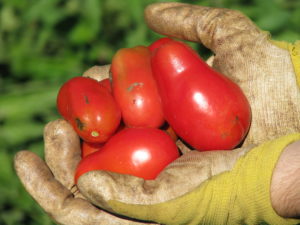
Tomatoes enjoy a good deep watering, and then let go dry in between. The tomatoes are more flavorful that way as well. Most of the tomatoes we harvested today came from volunteers that had popped up along our fenceline and receive no water, and others receive water once or twice a week along with the trees by which they are planted.
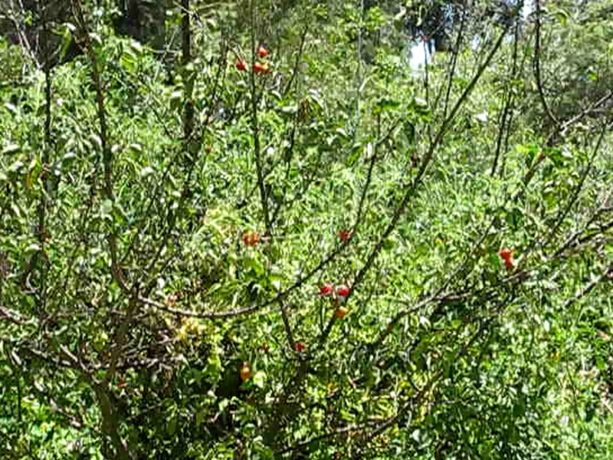
This apricot tree has been struggling with the heat and heavy clay in which its been planted, and as it has too few leaves there isn’t anything protecting the trunk and branches from the scorching heat… except for this tomato plant. The tomatoes vine upwards away from nibbling animals and are easy to pick, and the apricot receives shade. (Remember that growing under trees that have an upward growth is great, but only grow companion plants outside of the dripline of trees that have heavy skirts such as citrus and avocado).
When tomato vines die down, cut them at the soil surface
 and then either bury them or cover them with compost and then plant right around them. Worms love tomato vines and roots, and the vines will return nutrients to the soil.
and then either bury them or cover them with compost and then plant right around them. Worms love tomato vines and roots, and the vines will return nutrients to the soil.

 Also, tomatoes don’t care about being planted in the same place twice, so don’t worry about crop rotation. The only issue you might have is that if you plant a different variety the following year, seeds from the previous year’s tomato might come up there as well.
Also, tomatoes don’t care about being planted in the same place twice, so don’t worry about crop rotation. The only issue you might have is that if you plant a different variety the following year, seeds from the previous year’s tomato might come up there as well. If your tomatoes crack on the vine, that usually means too much water, or that you’ve dumped some fertilizer on them and the growth spurt was too quick for the expanding fruit. Don’t use chemical fertilizers. Period. For anything. If you dose the tomatoes with fertilizer you’ll have lots of vines and little fruit. Also, if the tomatoes have blossom-end rot (round black dents in the bottom of the fruit) it means there is a calcium deficiency, so to prevent this bury crushed egg shells where you’ll plant tomatoes, or pour sour milk or milk products around the tomato plants.
We have tomato hornworm in our garden,
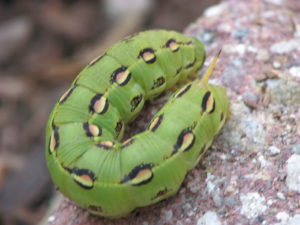 but they don’t get out of control because we have birds. They take care of most of the caterpillars in the garden. Besides, the tomato hornworm is the young of the Sphinx moth,
but they don’t get out of control because we have birds. They take care of most of the caterpillars in the garden. Besides, the tomato hornworm is the young of the Sphinx moth, 
a large lovely moth that you may see in the night.
If the temperatures remain tolerable this summer, we here at Finch Frolic Garden can look forward to lots of tomatoes to dry, can, freeze, eat fresh, make into sauce… whatever. Tomatoes are truly the taste of summer.
- Gardening adventures, Permaculture and Edible Forest Gardening Adventures, Planting, Soil, Vegetables
Growing Sweet Potatoes
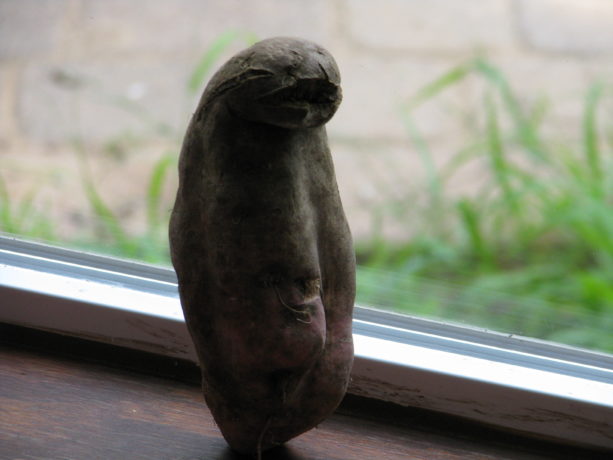 Sweet potatoes (Ipomoea batatas) were never one of my favorite foods… until I grew and ate one. It was a transformational experience. An entirely different experience from store-bought. If you’ve never had nor liked white sweet potatoes, grow one and try it. Or if you have to load marshmallows on top to get the orange ones down, you won’t need that gook with home grown.
Sweet potatoes (Ipomoea batatas) were never one of my favorite foods… until I grew and ate one. It was a transformational experience. An entirely different experience from store-bought. If you’ve never had nor liked white sweet potatoes, grow one and try it. Or if you have to load marshmallows on top to get the orange ones down, you won’t need that gook with home grown. 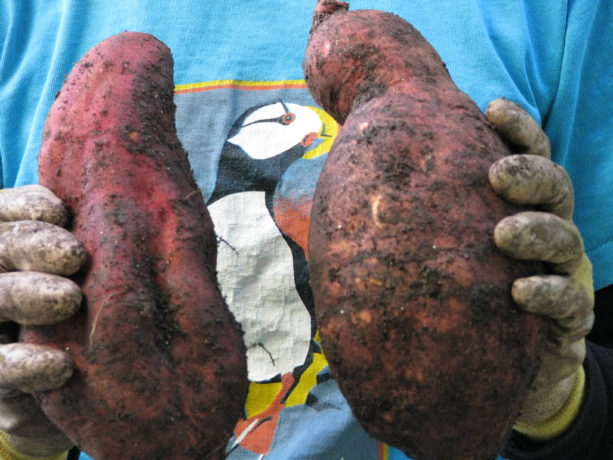
And by the way, what you find in a US chain store are all sweet potatoes, although the USDA calls the yellow ones yams just to make them different. A true yam has a rough bark-like skin and is an African dietary staple.
I put them in curries, steam them and top with a little vegan butter, cinnamon, chili-con-limon, a very light sprinkle of sugar and a squeeze of lime. I eat them here, I eat them there….. anyway, you get the picture. Not only are they low in fat and heavy in beta carotene, but people who eat a lot of healthy starches such as sweet potatoes, taro, cassava, potatoes, etc. have fewer chronic illnesses. Just don’t load the starch down with salt and fat.
Sprouting and growing your own sweet potato is different from growing the common potato, which is a swollen tuber in the solanaceae family. Sweet potatoes are tropical vines that need sunshine and warmth, and a lot of room to spread. Give them space or provide a support because the vines can sprawl ten feet.
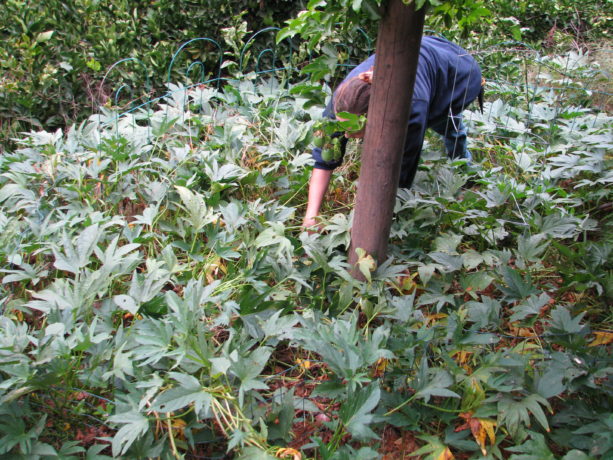 The shiny leaves, unlike potatoes, are edible and very decorative. You can grow them in large pots in the house as long as you have space for the vines (up and over the window?). The flowers are pretty, too.
The shiny leaves, unlike potatoes, are edible and very decorative. You can grow them in large pots in the house as long as you have space for the vines (up and over the window?). The flowers are pretty, too. 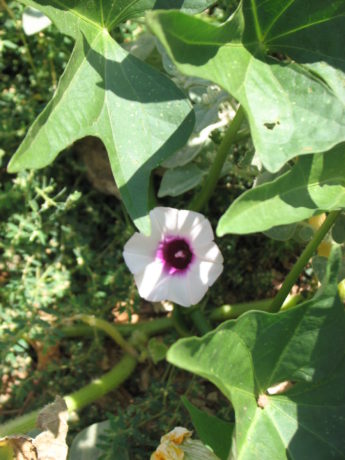
There are all kinds of sweet potatoes and crosses: purple inside, purple outside,
 yellow, orange,
yellow, orange,
 white and combinations thereof. They are all delicious. Some grow with clumps of potatoes directly under the plant, and some spread out and grow wherever the vine roots. You can grow them inside or outside, as long as they have warm soil and sunshine. For warmer areas, plant slips out in May or June. Its extremely easy to grow sweet potatoes. Here are some options:
white and combinations thereof. They are all delicious. Some grow with clumps of potatoes directly under the plant, and some spread out and grow wherever the vine roots. You can grow them inside or outside, as long as they have warm soil and sunshine. For warmer areas, plant slips out in May or June. Its extremely easy to grow sweet potatoes. Here are some options:Buy an organic sweet potato and keep it in a warm, dry, semi-dark place until you begin to see it sprout.
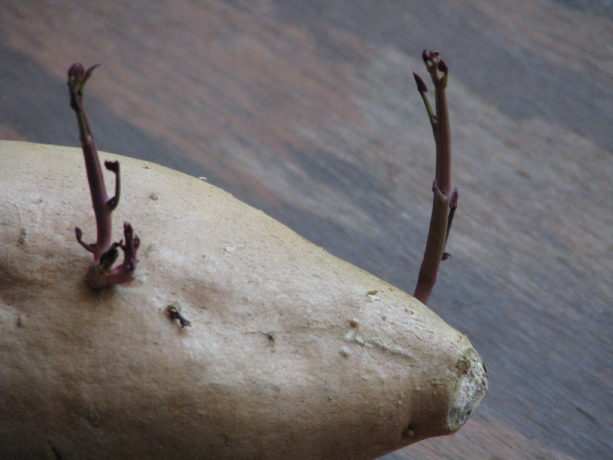 Allow these slips to grow until they are several inches long. Then give them a gentle pull; if they come off easily they are ready to root.
Allow these slips to grow until they are several inches long. Then give them a gentle pull; if they come off easily they are ready to root.  You can keep sprouting from that potato, or just eat it. Put the slips in a glass of water in a bright window for a few days and you’ll see them begin to root.
You can keep sprouting from that potato, or just eat it. Put the slips in a glass of water in a bright window for a few days and you’ll see them begin to root. After that they are ready to plant.
After that they are ready to plant.Or, take your organic sweet potato and cut it into wedges about an inch long. Suspend the chunk, cut-end down, over a glass of water so that the bottom is wet but the piece isn’t submerged. Do this by sticking three toothpicks around the sweet potato so that the toothpicks are over the edge of the glass. Many sprouts can come from a chunk, so you can keep harvesting until the base starts to go bad. Follow the directions above for removing the slip, rooting and planting it.
What you don’t want to do is to bury an entire sweet potato. It might sprout, but the plant will have all the nourishment it needs from the big potato and won’t form many if any new ones. By planting slips you are forcing the plant to grow storage units, or sweet potatoes.
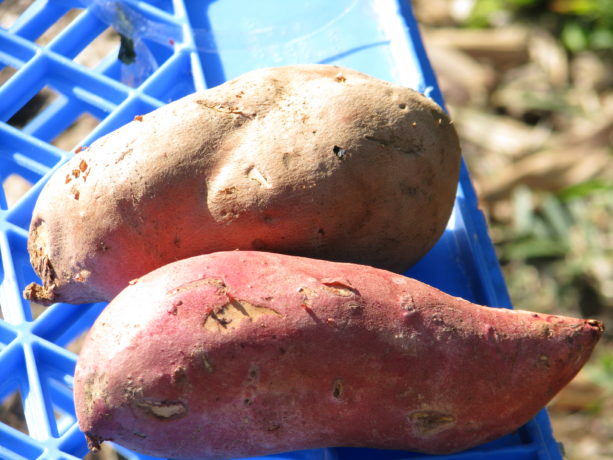
Be sure they are planted where the soil is well-draining, and watch out for animals in your area because sweet potatoes are very yummy to everyone. The soil should be enriched with compost, but not straight manure. Give the tubers a fighting chance by gently loosening up the soil under and around the planting hole with a garden fork. Remove any visible rocks or stones that might misshape or injure the tubers.
If you live where you can plant bananas outside, sweet potatoes are a great companion plant in a banana circle/guild. I’ve planted them as a groundcover (and choosing those varieties that root directly under the center, planted them in gopher cages). They are very ornamental.

In the right conditions you can grow sweet potatoes year round inside. Sweet potatoes want warmth so they are ideally suited to being planted indoors in areas where there are short summers. This is an excellent use for old fishtanks.

In the fall the vines will die off, and that is when you dig up the roots and enjoy them! Now you cure them – an important step for flavor development. Be sure that the roots are dry on the outside and keep in place at about 85F – 95F with a lot of humidity – about 80%, for five – ten days. They will develop a thicker skin, have a deeper flavor and be better keepers. Keep one for resprouting.

So sprout and grow your own, and don’t keep them just for Thanksgiving. Bake them like a regular potato and really enjoy a fabulously healthy meal. And maybe you’ll find one that looks like a walrus.

- Bees, Compost, Frost and Heat, Fungus and Mushrooms, Gardening adventures, Hugelkultur, Irrigation and Watering, Microbes and Fungi, Natives, Other Insects, Permaculture and Edible Forest Gardening Adventures, Rain Catching, Recycling and Repurposing, Reptiles and Amphibians, Seeds, Soil, Water, Water Saving, Worms
Shade
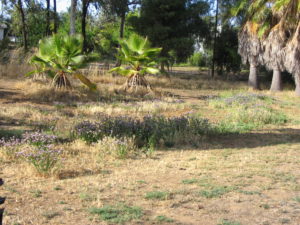
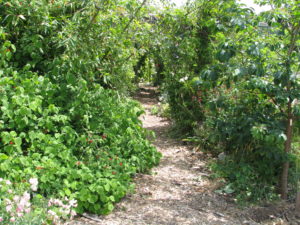 In drylands there is a noticeable lack of trees. This situation is kind of a Catch-22. The hotter and drier it is, the less water there is in the ground to provide for plants that can attain height, and the more the leaves of the existing trees must adapt (become smaller) to prevent transpiration and sunburn. Yet the very lack of trees and their extensive root systems, and the shade and habitat they create, and the transpiration that allows humidity to keep the air moist for pollen to survive, is one of the causes of desertification.
In drylands there is a noticeable lack of trees. This situation is kind of a Catch-22. The hotter and drier it is, the less water there is in the ground to provide for plants that can attain height, and the more the leaves of the existing trees must adapt (become smaller) to prevent transpiration and sunburn. Yet the very lack of trees and their extensive root systems, and the shade and habitat they create, and the transpiration that allows humidity to keep the air moist for pollen to survive, is one of the causes of desertification.So how do we stop this cycle?
First, work on a manageable area. If you have a large property, then start on the area closest to your home or where you need water the most, or where water settles. As in the Annie Lamont title, Bird by Bird, you work on a piece a little at a time.
- Put in earthworks to harvest rainwater. Simple swales or rain catchment basins, perpendicular to the water flow and on contour with your property, will harvest hundreds of gallons of water each rain. You can do them with tractors, you can do them with shovels, you can do small ones with trowels above small plants. Just do them.
- Bury organic matter: hugelkultur. Do you have old wood laying around? Palm trees that are growing and being a fire hazard? Old untreated lumber full of nails? Branches? All of this can be layered into the ground. Bury organic matter downhill from your swales. If you cannot bury, then pound sticks vertically into the ground. The important thing is that you are adding organic material back into your depleted soil. It will hold rainwater, it will activate soil microbes and fungi, it will open oxygen and nutrient channels, it will sequester carbon and make it available to the plants. Our soil is mostly just dead dirt. By layering organic material with dirt you are doing what nature does, but at an accelerated pace.
 If your soil is unmanageable, or you can’t dig, then layer on top of the soil. Its called, among other things, lasagne gardening. Lay out newspaper, top it with fresh grass clippings or other greens, top that with dried grass clippings, dried leaves or other ‘brown’ materials, and depending upon what you want to plant in this, you can top it with mulch or with a layer of good compost and then mulch. Then plant in it! You create soil on top of the ground.
If your soil is unmanageable, or you can’t dig, then layer on top of the soil. Its called, among other things, lasagne gardening. Lay out newspaper, top it with fresh grass clippings or other greens, top that with dried grass clippings, dried leaves or other ‘brown’ materials, and depending upon what you want to plant in this, you can top it with mulch or with a layer of good compost and then mulch. Then plant in it! You create soil on top of the ground. - Mulch and sheet mulch! Protect your soil from the heat and wind, and from pounding rain. A thin layer of bark will actually heat up and accelerate the evaporation process: add several inches of mulch to the ground. Better yet, sheet mulch by laying cardboard and/or newspaper directly on top of the weeds and layering an inch or more of mulch on top.
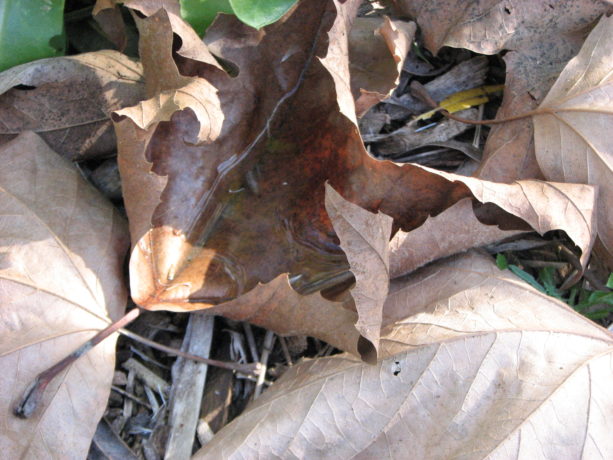 This can be free mulch from landscapers, old weeds, grass clippings, animal bedding, softwood cuttings… just cover the soil to keep it moist and protected. Thick mulching alone will help keep some humidity in the air and begin soil processes, as well as reduce evaporation by reflected heat that comes from bare earth or gravel.
This can be free mulch from landscapers, old weeds, grass clippings, animal bedding, softwood cuttings… just cover the soil to keep it moist and protected. Thick mulching alone will help keep some humidity in the air and begin soil processes, as well as reduce evaporation by reflected heat that comes from bare earth or gravel. - Plant native plants. They thrive in our soil. Grow trees that filter the sun and don’t like a lot of water, such as palo verde, or those that take minimal additional water such as desert willow, California redbud, valley oak, or others. Grow tall bushes such as toyon, lemonadeberry, sugarbush, quailbush, ceanothus
 or others. Use these wonderful plants to invite in birds,butterflies, lizards and other wildlife that will begin pollination and help activate the soil.
or others. Use these wonderful plants to invite in birds,butterflies, lizards and other wildlife that will begin pollination and help activate the soil. - Design your garden for what you want to grow besides natives. Fruit trees? Vegetables? Ornamentals? They can be arranged in your mulched area in guilds to grow cooperatively.
- Grow shade. Fast-growing trees and shrubs are invaluable for protecting – ‘nurserying in’ – less hardy plants. Acacia and cassia are both nitrogen-fixers and will grow quickly to shade your plants, can be cut for green waste in the fall and also attract pollinators. Moringa is completely edible and is also an excellent chop-and-drop tree. There are many others. You need to protect what you plant from the harsh summer sunlight, and using sacrificial trees and shrubs is the most productive way to do it.
- Protect your tree trunks from scorching by growing light vines up them, such as beans or small squash.
Once you have done this process in one area, then move on to the next, like a patchwork quilt. These areas should all be planted in accordance with a larger plan that covers your entire property, so that you plant what you want in the best possible place. However, the earthworks, hugelkultur and mulching can be done everywhere. By following these guidelines, and working one small area at a time, you’ll have success, have trees, shade, food and be helping reverse desertification, one plot at a time.
- Animals, Birding, Gardening adventures, Microbes and Fungi, Ponds, Rain Catching, Water, Water Saving
Mallards in May
 Every year our two wild mallards linger in our chemical-free pond. They mate, Mrs. Mallard disappears for awhile, returns with very small ducklings and… they all die within days.
Every year our two wild mallards linger in our chemical-free pond. They mate, Mrs. Mallard disappears for awhile, returns with very small ducklings and… they all die within days. Why? She hasn’t been a great mama. She runs them around too much, doesn’t preen them or give them time to eat. So this year when she showed up with four ducklings I didn’t even want to take photos of them. Who knows how many she began with? But these ducklings were a little older and larger than other batches had been. And they survived.
Why? She hasn’t been a great mama. She runs them around too much, doesn’t preen them or give them time to eat. So this year when she showed up with four ducklings I didn’t even want to take photos of them. Who knows how many she began with? But these ducklings were a little older and larger than other batches had been. And they survived.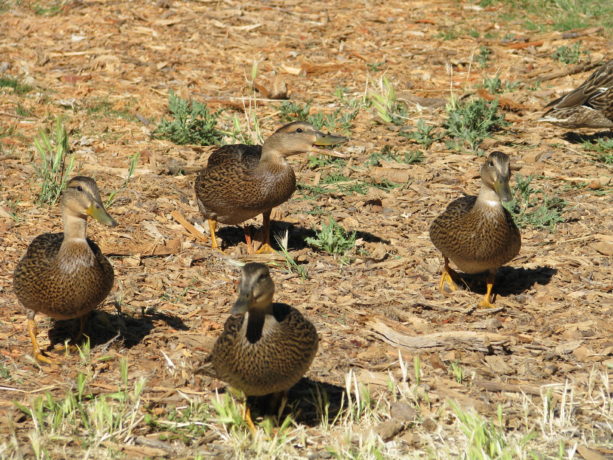 They weren’t eaten by the bullfrogs in the pond, or snatched by birds, or neglected by mama. We put out wild game bird food to help them along, but Mrs. Mallard has taught them how to dabble for vegetation (they eat mostly greens).The ducklings make a ‘weep-weep’ sound when they are asking for food.
They weren’t eaten by the bullfrogs in the pond, or snatched by birds, or neglected by mama. We put out wild game bird food to help them along, but Mrs. Mallard has taught them how to dabble for vegetation (they eat mostly greens).The ducklings make a ‘weep-weep’ sound when they are asking for food.  One day she repeatedly dove and came up under them, and then swam underwater to the other side of the pond and back: she was teaching them how to swim underwater! Now these babies have lost their downy feathers and are growing in their primaries. They’ll be off soon, hopefully to return. Mr. Mallard has been keeping an eye on Mrs. Mallard; he sometimes pushes the babies out of the way of the food, for which we chastise him greatly.
One day she repeatedly dove and came up under them, and then swam underwater to the other side of the pond and back: she was teaching them how to swim underwater! Now these babies have lost their downy feathers and are growing in their primaries. They’ll be off soon, hopefully to return. Mr. Mallard has been keeping an eye on Mrs. Mallard; he sometimes pushes the babies out of the way of the food, for which we chastise him greatly. 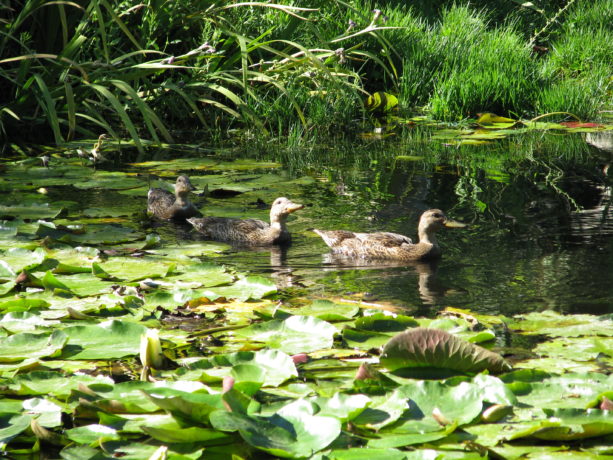 His breeding plumage is holding so if the young fly off soon, he might try for a second mating this season.
His breeding plumage is holding so if the young fly off soon, he might try for a second mating this season. Meanwhile, Mama Mallard looks pretty smug.
Meanwhile, Mama Mallard looks pretty smug. Over 97% of California’s wetlands are completely gone, and what’s left is compromised by roads, pollution and management. Those billions of animals and trillions of insects which depended upon those wetlands have mostly died off, or make do with chlorinated water from the billions of swimming pools and bird baths they can find. The wildlife you see is a tiny remnant of what should be here.
To have a pond with rain water or well water in it, cleaned by fish and plants rather than chemicals, is to have a haven for wildlife. Good water is diverse with life, just as good soil is, and instead of drinking wet chemicals animals can drink water that is imbued with nutrients. The thousands of insects, reptiles, amphibians, mammals, marsupials and birds that use our pond are healthy because the water is not chlorinated. If you can put any size of pond – even in barrels – using rainwater and cleaned by plants and fish, you’ll be doing wildlife and yourself a service.
And here’s our ducklings dabbling for greens this morning:
MVI 0996
Older ducklings dabbling in Finch Frolic Garden pond, May 1, 2017.
- Animals, Arts and Crafts, Bees, Birding, Building and Landscaping, Chickens, Fungus and Mushrooms, Gardening adventures, Heirloom Plants, Hugelkultur, Microbes and Fungi, Natives, Other Insects, Perennial vegetables, Permaculture and Edible Forest Gardening Adventures, Photos, Ponds, Rain Catching, Recycling and Repurposing, Soil, Water, Water Saving
Six Years of Permaculture

 In February, 2011, I signed the contract with Roger Boddaert to create a permaculture food forest. The goals at that time were to stop the erosion on the property, to create a wildlife habitat, and to grow food, medicine, native plants, building materials, herbs and ornamentals in a sane way: no chemicals. So the journey began, and it hasn’t been easy. Nor did I at that time know that the garden would evolve into Finch Frolic Garden and my business would be education.
In February, 2011, I signed the contract with Roger Boddaert to create a permaculture food forest. The goals at that time were to stop the erosion on the property, to create a wildlife habitat, and to grow food, medicine, native plants, building materials, herbs and ornamentals in a sane way: no chemicals. So the journey began, and it hasn’t been easy. Nor did I at that time know that the garden would evolve into Finch Frolic Garden and my business would be education. In preparing for a talk about our garden, Miranda and I worked on before and after photos. The garden this April, 2017, is stunning, with blooming wisteria, fruit trees, red bud, roses, angel-wing jasmine, iris, and so much more. Best of all Mrs. Mallard has brought her annual flock of ducklings from wherever she nests, and the four babies are still alive and thriving after a week! So I thought I’d share the incredible difference between what had been, and what is now. All done with low water use, no fertilizer, herbicide, insecticide, additives or supplements. Come visit when you can! Slideshow images change in ten seconds:
- Building and Landscaping, Compost, Gardening adventures, Hugelkultur, Irrigation and Watering, Natives, Permaculture and Edible Forest Gardening Adventures, Ponds, Rain Catching, Soil, Water, Water Saving
Installing a Swale
 Last Saturday we hosted our first workshop of 2017, featuring Alden Hough of Sky Mountain Permaculture. Alden is a master at creating earthworks, and he spent three hours here at Finch Frolic Garden teaching a class of sixteen people how to install swales correctly.
Last Saturday we hosted our first workshop of 2017, featuring Alden Hough of Sky Mountain Permaculture. Alden is a master at creating earthworks, and he spent three hours here at Finch Frolic Garden teaching a class of sixteen people how to install swales correctly. 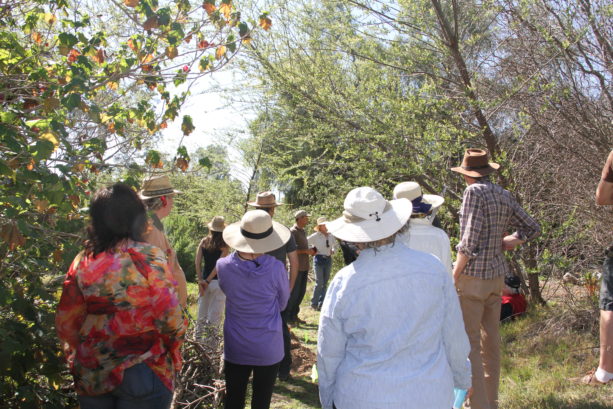 The project was a small pond that overflowed and flooded when heavy rains hit. The soil is heavy clay and therefore the small pond doesn’t percolate. It is kept filled by the well, and its overflow feeds the bog and the big pond. Right now the little pond is full of native Pacific chorus frog tadpoles, which will evolve into small frogs that will go out into the landscape and eat bugs the rest of the year.
The project was a small pond that overflowed and flooded when heavy rains hit. The soil is heavy clay and therefore the small pond doesn’t percolate. It is kept filled by the well, and its overflow feeds the bog and the big pond. Right now the little pond is full of native Pacific chorus frog tadpoles, which will evolve into small frogs that will go out into the landscape and eat bugs the rest of the year.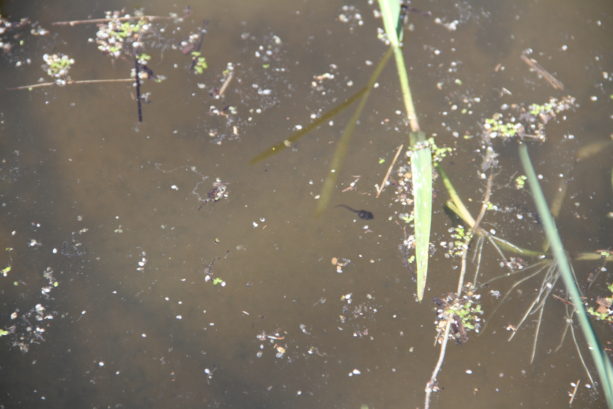 He created a urbanite (cement chunks) spillway into a twenty-foot swale. The class learned what a bunyip was and how to use the water level, and how to use a laser level. The swale will hold about 300 gallons of water that would have overflowed into another area, spread and sink the water.
He created a urbanite (cement chunks) spillway into a twenty-foot swale. The class learned what a bunyip was and how to use the water level, and how to use a laser level. The swale will hold about 300 gallons of water that would have overflowed into another area, spread and sink the water. 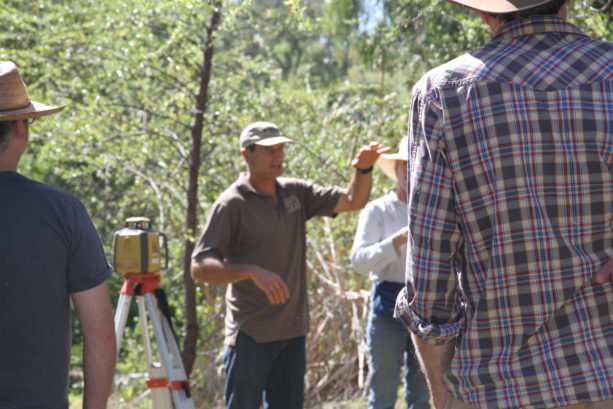
The swale was measured and marked on contour.
 Bermuda grass was pulled from it and set into trash cans to cook in the sun and hopefully be destroyed. The swale was then dug by hand.
Bermuda grass was pulled from it and set into trash cans to cook in the sun and hopefully be destroyed. The swale was then dug by hand. Old wood – branches, logs, boards and old posts – were laid below the swale, and covered by the dirt. This hugelkultur will absorb seeping water, aerate and enrich the soil, and provide food and water over time for the trees downhill.
Old wood – branches, logs, boards and old posts – were laid below the swale, and covered by the dirt. This hugelkultur will absorb seeping water, aerate and enrich the soil, and provide food and water over time for the trees downhill.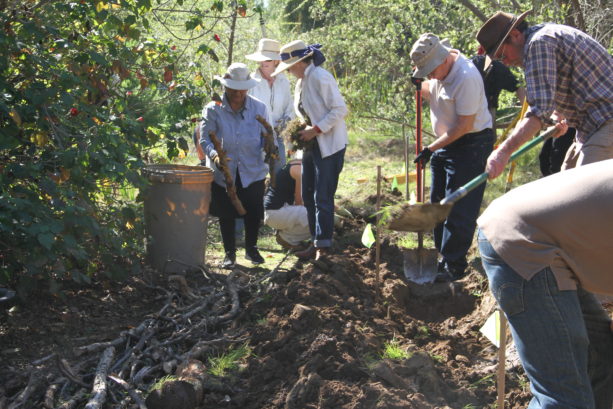 More dirt was needed to cover the wood so we emptied the first rain catchment basin on the property of silt and hauled it down the hill. This was a lot of heavy work, and several of our attendees worked extremely hard with the wheelbarrows. Miranda and I have a lot of experience doing this heavy work, and we are glad that this swale project also emptied this basin.
More dirt was needed to cover the wood so we emptied the first rain catchment basin on the property of silt and hauled it down the hill. This was a lot of heavy work, and several of our attendees worked extremely hard with the wheelbarrows. Miranda and I have a lot of experience doing this heavy work, and we are glad that this swale project also emptied this basin. Our wonderful workshop attendees worked very hard in the heat. The end result was a swale of beauty.
 By creating level swales dug on contour, you can see how right it looks. It hasn’t been dug deeper into the ground at one end to force the swale to be level. If you measure on contour your swale can be of any size, and it will collect, passify, spread and sink rainwater into the landscape. Earthworks are the best way to hold water, and are imperative to reestablishing water tables, keeping wells running, keeping trees alive and maintaining springs and streams. A little earthworks will make a huge difference.
By creating level swales dug on contour, you can see how right it looks. It hasn’t been dug deeper into the ground at one end to force the swale to be level. If you measure on contour your swale can be of any size, and it will collect, passify, spread and sink rainwater into the landscape. Earthworks are the best way to hold water, and are imperative to reestablishing water tables, keeping wells running, keeping trees alive and maintaining springs and streams. A little earthworks will make a huge difference.What needs to be done now is to create a dedicated overflow from the swale into the main pond. As this area receives a lot of foot traffic, we’ll also need to haul more silt to make the raised walkway more gradual and blended with the paths around. Once the tadpoles have grown and left the pond, we can drain it and use that silt. Two projects in one.
Prior to the project Miranda carefully removed a lot of healthy creeping red fescue from the work site. After the swale and spillway were dug she replanted some of it. Native yarrow will also be planted to help hold the swale.
A huge thanks to the many people who came to learn and work on site. No matter how many movies you watch or books you read, having hands-on experience makes the education click. And an extra huge thanks to Alden Hough for his expertise and hard work. Please visit Sky Mountain Permaculture in Escondido for more classes – earth bag dome building included – coming up there.
Our next Finch Frolic Garden workshop will be in April: April 22, 2pm – 4pm: The Many Benefits of Trees: Care, Nurturing and Pruning . Roger Boddaert, the Tree Man of Fallbrook and professional landscaper who planned the original garden that would evolve into Finch Frolic Garden, will talk about trees. So many trees are dying due to the drought, and we need to replace them to help shade and cool the earth and hold onto moisture. But what to plant, where and how to care for them? Roger will take you through tree care based on fifty years of experience in landscaping. Visit https://www.southernpalmetto.com/services/ and get all the details.
Go forth and dig swales!
- Building and Landscaping, Compost, Gardening adventures, Hugelkultur, Irrigation and Watering, Permaculture and Edible Forest Gardening Adventures, Rain Catching, Soil, Water, Water Saving, Worms
Earthworks Workshop
Happy March! Finch Frolic Garden is officially open, and the trees are bursting into leaf and bloom. Birds are twitterpating and the ten inches of rain we’ve received since October are slowly working through the soil thanks to our earthworks.
Here’s an opportunity to learn just how to create accurate swales and hugelkultur so that they work. Saturday March 11th from 1 -4 we have the privilege of having Alden Hough from Sky Mountain Permaculture hold our first monthly workshop here in the garden. Alden has
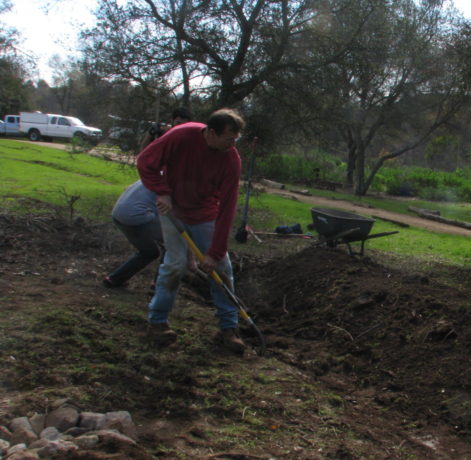 years of experience with building earthworks on all scales, from guiding excavators across hillsides to hand-dug. Alden will describe how to build swales and hugelkultur beds, show off equipment, and then its hands-on in the garden. You’ll learn how to use a laser level and a bunyip, and get the feel of how to build on contour. Bring your gloves and be prepared to have some fun creating earthworks, so that you can do it properly on your own property.
years of experience with building earthworks on all scales, from guiding excavators across hillsides to hand-dug. Alden will describe how to build swales and hugelkultur beds, show off equipment, and then its hands-on in the garden. You’ll learn how to use a laser level and a bunyip, and get the feel of how to build on contour. Bring your gloves and be prepared to have some fun creating earthworks, so that you can do it properly on your own property.The workshop fee is $20/person. Please RSVP to dianeckennedy@prodigy.net. Wear appropriate work clothes and sun protection. Complimentary vegetarian refreshments will be available. Attendees may stroll Finch Frolic Garden as well. Don’t wait!
-
Zone 0: Taking Care of Yourself
I just spoke with a vibrant, funny friend of mine who happens to be in her 90’s. She told me that she had slipped in the bathtub and couldn’t get out (it was dry) for a day and a half. She beat on the wall hoping her neighbor would hear, and then finally heard someone walking their dog on her lawn and she screamed until the woman called 911. Fortunately she only broke a couple of ribs, but is black and blue and deeply embarrassed. She couldn’t reach the taps, which are placed high for easy access, so she was dehydrated, not to mention hungry.
Another friend several years ago fell in her home, hit her head, and couldn’t get up. She was there with her poor dog for three days until someone came. She is only in her sixties, and she never fully recovered from this; she’s since sold her home and moved into a senior care center.
Still another friend years ago slipped, hit her head, lay on the floor for several days, and then died before anyone came. A horrible death for a wonderful woman.
My yoga teacher, Ann Wade from Wade Into Fitness here in Fallbrook (a well-deserved plug!) is always preaching that you must be able to get up from the floor. It seems so simple, but without practice those muscles can be lost. She’s also big on balancing exercises, which help you prevent falls.
One of the three ethics of permaculture is ‘people care’, and fundamentally that means your own personal health. In permaculture, designs are defined by zones of usage, from 1 to 5, and your personal health is often referred to as Zone zero, or the epicenter of everything that happens. You can’t do a lot of good for others if you are ill, yet there are few of us who keep a good balance of food and exercise. Some are hypochondriacs, some overwork figuring the body just has to keep up (I’m a bit on this side). Your body will always hand you the bill in your middle and old age for what you’ve done to it early on, so be good to yourself.
This post is for all ages. If you get up and down from the floor easily, keep it up. Practice. If you have a hard time or can’t, then you have to work on it. No matter your age you can build muscle. Make sure that your arms are strong enough to pull you up. Work on balancing exercises in a safe environment. Find a healing yoga class or strength-building class and practice your balance and your ability to get up from the floor.
Please take care of yourself, for your own sake and for the sake of your family and friends, and for all those people who look forward to seeing you smile.
- Frost and Heat, Gardening adventures, Permaculture and Edible Forest Gardening Adventures, Vegetables
Manipulating Cold
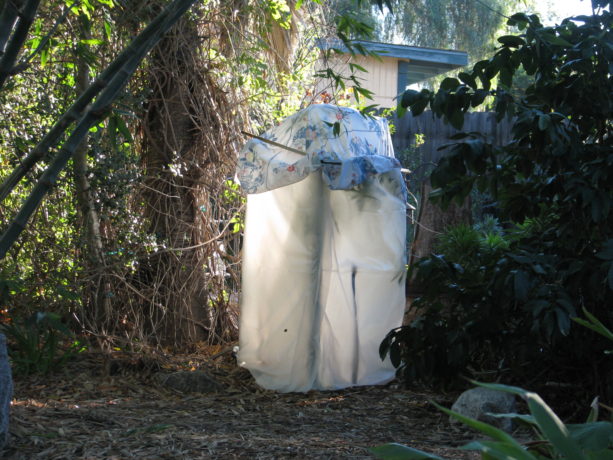 In areas such as here in flatland San Diego we don’t receive a lot of cold. We’re growing both tropicals which don’t want the frost, and stonefruit, brassicas and other plants that do better with a good chill. So when frost comes we need to manipulate it.
In areas such as here in flatland San Diego we don’t receive a lot of cold. We’re growing both tropicals which don’t want the frost, and stonefruit, brassicas and other plants that do better with a good chill. So when frost comes we need to manipulate it.Of course the best possible practice is to plant where there are optimal conditions for your particular types of plants and trees. Trees that need chilling should go down where frost settles. Tropicals should go higher where frost will roll past. However, circumstances change and you can’t be perfect all of the time, so here are some tips for helping your plants receive what they need:
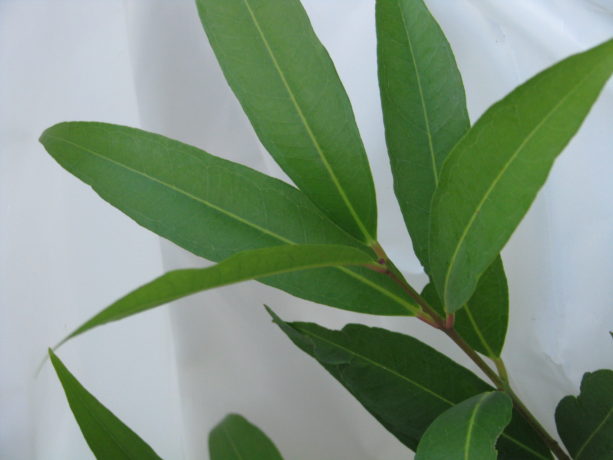 For young tropicals, some frost protection through the first winter is important. A very easy way to protect your trees is to set four stakes around the tree; the poles should be taller than the tree.
For young tropicals, some frost protection through the first winter is important. A very easy way to protect your trees is to set four stakes around the tree; the poles should be taller than the tree.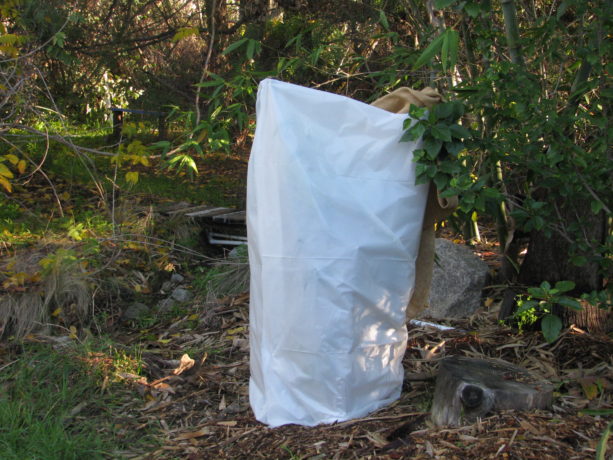 As much as I don’t like to use plastic, a 6 mil white plastic works best for this. Otherwise wrap in heavy burlap, blankets, etc. The thing about white plastic is that it lets in light so that you can set this up at the beginning of the cold season and leave it up until after the last frost. I open and close the top just on nights when it is going to be frosty.
As much as I don’t like to use plastic, a 6 mil white plastic works best for this. Otherwise wrap in heavy burlap, blankets, etc. The thing about white plastic is that it lets in light so that you can set this up at the beginning of the cold season and leave it up until after the last frost. I open and close the top just on nights when it is going to be frosty.Wrap the plastic around the poles, allowing some to be on the ground in a skirt which you can hold down with rocks, and some to extend above the top of the tree. Staple the plastic to the wooden poles. Frost rolls across the ground like water, so you want to make sure that it can’t roll under your plastic. It also comes down like water so you want to protect the top leaves. You can have a plastic flap that you can secure – tie down if its windy – over the top.
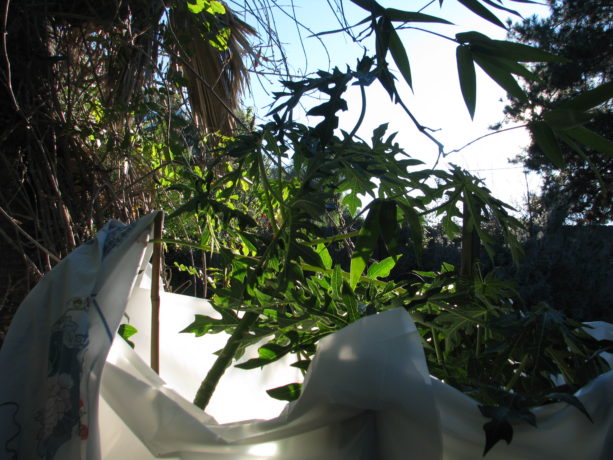 I used several layers of burlap on my mango and rose apple trees, and I’m using an old sheet on my papaya, as if that frosts at the top it will come back the next year, and I didn’t have poles tall enough to reach above the highest leaves. Burlap, particularly wet burlap, would be too heavy.
I used several layers of burlap on my mango and rose apple trees, and I’m using an old sheet on my papaya, as if that frosts at the top it will come back the next year, and I didn’t have poles tall enough to reach above the highest leaves. Burlap, particularly wet burlap, would be too heavy.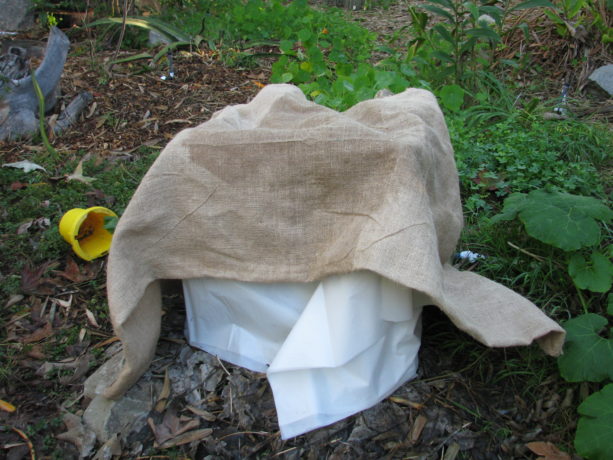
Be sure to uncover the tops of your plants in the morning so that they don’t cook. The plastic will act like a small greenhouse and help your plants keep cozy during cold days as well. This is a treat for a tomato that came up next to our mango and is enjoying the greenhouse effect.
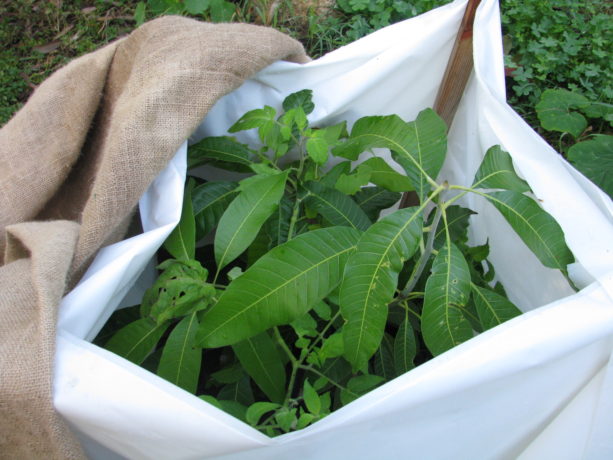
So what to do about capturing cold? Again, frost rolls downhill. Capturing it with obstacles such as earthen walls, stacked sandbags, bushes, railroad ties, or anything that keeps it from passing by will help deliver the chill hours needed. Be sure that the cold trap is created like a smile downhill of the plant; fishscale swales are in the same direction but placed above plants for water catchment. You want the cold to be caught in a cup.
This short video I took last week on Christmas day showed a very light frost, and how dramatically different it was between a path that had no obstacles, and the side that had.
https://youtu.be/1YgG7sTDfrA
After I shut the camera off I realized that I should also have wished you a Happy Hanukkah, an early Happy Kwanzaa, a general Happy Holiday for others, and now I wish you a Happy New Years, as we are five hours before the end of 2016.
Thanks for reading, thanks for doing permaculture and helping to save the planet. We can make the change we want to see happen.
- Compost, Gardening adventures, Hugelkultur, Irrigation and Watering, Permaculture and Edible Forest Gardening Adventures, Ponds, Rain Catching, Seeds, Soil, Water, Water Saving
Swales and Basins in Action!
 This week here in Fallbrook, CA, at Finch Frolic Garden we received almost three inches of rain in 18 hours. Our storm pattern is changing so that there are fewer rain events, but when it rains, it really rains.
This week here in Fallbrook, CA, at Finch Frolic Garden we received almost three inches of rain in 18 hours. Our storm pattern is changing so that there are fewer rain events, but when it rains, it really rains. 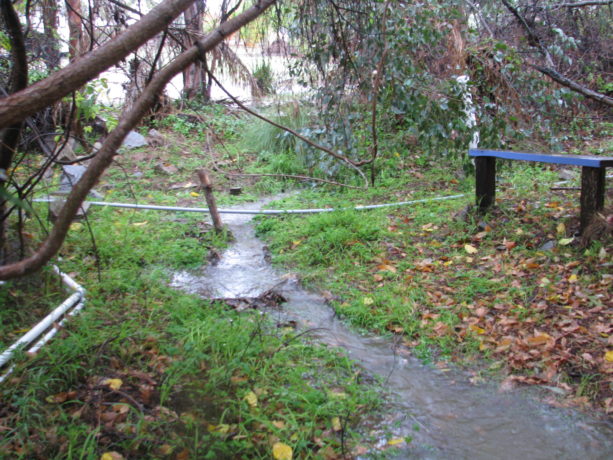 For many this was a flood. Precious rainwater is channeled away from properties and into the street. In permaculture gardens the water is harvested in the earth with simple earthworks such as swales (level-bottomed ditches) and rain catchment basins.
For many this was a flood. Precious rainwater is channeled away from properties and into the street. In permaculture gardens the water is harvested in the earth with simple earthworks such as swales (level-bottomed ditches) and rain catchment basins.Visitors have often expressed their desire to see the earthworks in action, so I took my camera out into the food forest.
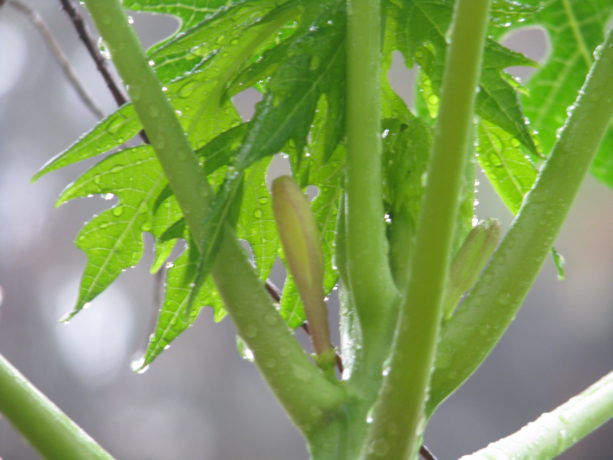 That was when the rain gauge was at about two and three quarters, with more to come. (I wanted to photograph the garden after the storm had passed but my camera refused to turn on due to the indignity of having been wet. A couple of nights in a bag of rice did it wonders.)
That was when the rain gauge was at about two and three quarters, with more to come. (I wanted to photograph the garden after the storm had passed but my camera refused to turn on due to the indignity of having been wet. A couple of nights in a bag of rice did it wonders.)
Please excuse the unsteady camerawork, and my oilskin sleeve and dripping hand making cameo appearances in the film. I was using my hand to shield the lens from the rain.




